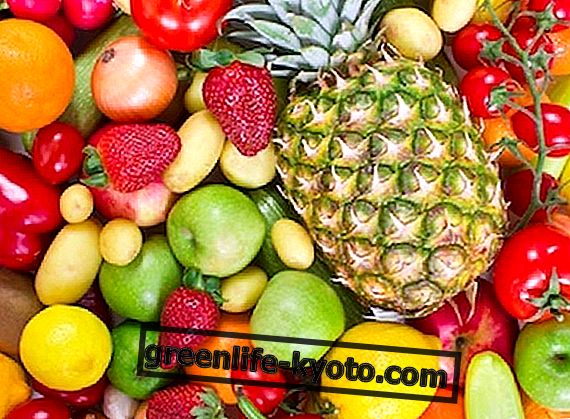Foods rich in vitamin B6, such as whole wheat flour and rice, are useful for the correct functioning of the nervous system and for protein transformation processes. Let's find out better.
Rice, rich in vitamin B6

Properties of vitamin B6
Vitamin B6 is composed of three parts: pyridoxine, the name with which it is equally known, pyridoxal and pyridoxamine. These substances play an important motion action in the human body, especially with regard to metabolism and protein transformation processes .
It is an essential vitamin in the production of energy, red blood cells and some brain and nervous system functions, such as the synthesis of neurotransmitters serotonin and norepinephrine and for the formation of myelin.
Main foods rich in vitamin B6
Vitamin B6 can be found in various foods, including products based on wholemeal flour (for example , wholemeal bread ), in rice, in fruits such as avocado and bananas, in hazelnuts, in peanuts, in sunflower seeds, in the germ of wheat, in brewer's yeast.
It is present in many vegetables, especially in peppers, spinach, broccoli, carrots and turnip greens and legumes (especially lentils). It is also found in certain fish, such as tuna, salmon and shellfish (shrimp).
A lack of vitamin B6 is quite rare, as it is easily synthesized by the body through a varied and balanced diet.
Wheat germ
Contains 3 mg of vitamin B6 per 100g, a quantity that makes it one of the foods richest in this nutrient. In addition to this, we find the Omega 3, Omega 6 and vitamin A and D acids, valid aids in maintaining the health of skin and hair and to counteract the negative effect of free radicals. The wheat germ is sold in the form of light flakes that can be used raw in milk and cereals, in soups, in salads (where you can also put wheat sprouts) or in yoghurt.
Avocado
The avocado contains 0.3mg per 100 grams, it is a precious food, also rich in omega 3, manganese, vitamins C and E. Thanks to selenium and zinc and carotenoids, they are considered powerful anti-inflammatories and antioxidants natural, useful for the well-being of the heart and circulation, given the content of vitamin B6 and folic acid. The advice is to buy them beautiful ripe, they must be soft to the touch, so you can prepare at least one guacamole sauce a week; alternatively you can taste them in salads, or in sandwiches.
peppers
A precious food, the pepper contains about 0.12 mg of vitamin B6 per 100 grams of product. In addition to this, we also find vitamins C and A and magnesium. Excellent if you follow a vegan or vegetarian diet, the pepper helps to strengthen the immune system, helps iron absorption, makes the body more active and reactive. In addition to eating it raw in salads, where it gives its best in terms of nutritional intake, it can also be cut into cubes, together with a yellow pepper, to make it a tasty risotto alla vogherese.
Lentils
Excellent food not only for vegans and vegetarians, lentils are composed of water, proteins, dietary fiber, carbohydrates and sugars; minerals include magnesium, potassium and phosphorus, but also calcium, sodium, iron, zinc, copper, others. Lentils also contain B vitamins, namely vitamins B1, B2, B3, B4 and B6, vitamin C, k, J and little vitamin E. Excellent if combined with cereals, such as rice or pasta, they become a complete food and nutritious.
Brewer's yeast
Fresh brewer's yeast contains many valuable substances, including vitamins B6, B5, B9 and B2. Useful for ensuring good health for skin, nails and hair, brewer's yeast also helps treat constipation or colitis and is an excellent food to raise the immune defenses of those who have suffered severe stress or trauma. It also contains essential proteins and amino acids, is particularly recommended for athletes and those who follow vegan or vegetarian diets.
Also find out what are the natural vitamin B6 supplements

Brewer's yeast among vitamin B6 supplements
Daily requirement of vitamin B6
The need for vitamin B6 is related to the amount of protein taken with the diet. The recommended intake level is calculated for adults at 1.5 mg per 100 g of dietary protein .
The recommended intake levels increase by about 20% in the case of pregnancy and 30% in the case of breastfeeding. In children up to the age of 12 the mg should not be exceeded per day, while in adolescents it starts to rise to 1.3mg for males and 1.2 for females.
Vitamin B6 rich recipe
guacamole
Ingredients for two people: a ripe avocado, a teaspoon of lemon or lime juice, a couple of cherry tomatoes, half an onion, salt and pepper
Procedure : Peel and remove the seed avocado, cut it into pieces and put it in a cup with the squeezed lemon or lime juice, crush it with a fork or a potato masher, creating a soft cream in which some small internal pieces will remain. Add the finely chopped white or golden onion and mix again.
Season with salt and pepper and then add the diced tomatoes. Nb: pay attention to the purchase of the avocado: it doesn't have to be hard, otherwise you would have to use the mini pimer or electric blender to make the sauce, and it's not the same thing! At most leave it out of the fridge with the other fruit for a few days before using it.













